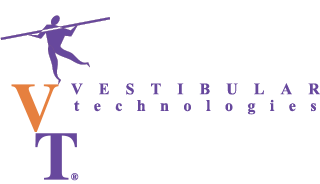BalanceTRAK®
Together with our CAPS® Professional force platform, the user friendly, but extremely powerful BalanceTRAK® offers you the latest in cutting edge technology for:
- advanced balance testing
- physical performance testing and treatment
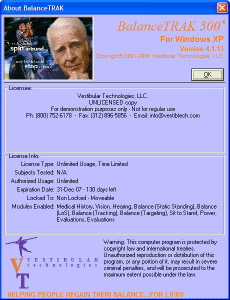
Together with our CAPS® Professional force platform, the user friendly, but extremely powerful BalanceTRAK® offers you the latest in cutting edge technology for:

Using the CAPS® Professional Force Platform, BalanceTRAK® lets you perform several specialized tests with unparalleled flexibility and control of test parameters, allowing you to obtain essential information about your subject's balance system and physical performance that was never before available to you.
Although BalanceTRAK® consists of a collection of different modules working in a single unified framework, each module operates independently so you can purchase only the modules you need for your particular setting.
Available modules include:
BalanceTRAK® lets you easily document diagnostic testing, therapy progress and treatment outcomes.
It facilitates compliance with JCAHO and other bodies regarding fall prevention and provides the objective and documented evidence that many health insurers are now requiring.
Because BalanceTRAK® lets you test subjects in an unprecedented variety of test conditions, it can be a very beneficial tool for you to use in the diagnosis of balance and other disorders.
Remember, too, that BalanceTRAK® and the CAPS® Professional Force Platform can be used not only with fully ambulatory subjects, but also with subjects using support aids such as canes or walkers ‑ even with subjects that are completely unable to stand.
Although originally conceived as clinical tools, the various BalanceTRAK® modules have many applications in athletics/sports medicine.
With BalanceTRAK® you can not only identify and evaluate factors limiting the subject's balance, you can also put the subject through a number of specialized physical performance tests, then measure, quantify and document the subject's progress while engaging in valuable biofeedback exercises tailored to the individual subject.
Plus, BalanceTRAK®'s rugged portability lets you use it not only in well controlled environments, but also directly on the sidelines.
It is designed to quickly collect a subject's medical history, focusing on the factors that are often present in connection with balance disorders, hearing loss, dizziness, tinnitus, falls and near‑falls.
Unlike any other product on the market, this module allows a complete medical history to be taken by entry level personnel who have had only minimal training. Intuitive instructions guide the user through the simple interface screens where a series of questions are presented in a logical and comprehensive way, with immediate checks to ensure that all important information has been collected before proceeding to the next screen.
Because it is tailored to health problems like dizziness and balance disorders and is designed to be used by untrained personnel, it is much more comprehensive than any general medical history collection software or paper product.
BalanceTRAK® Medical History Module simplifies and streamlines the often complex process of obtaining an effective anamnesis from a subject.
Based on the subject's responses, the module uses an intelligent built‑in decision tree to dynamically present only those questions that are appropriate for that specific person's medical history and symptoms.
After all information has been recorded, a detailed summary of the data gives the health care provider a comprehensive picture of the health and well‑being of the subject, allowing the clinician to better formulate appropriate diagnosis and treatment.
Since BalanceTRAK® supports multiple visits, it is possible to use this module not only to collect the medical history as part of an intake visit, but also to collect the initial history during subsequent visits. It is also possible to collect and update an old history or to collect and record changes at various stages of the person's treatment.
The fact that the medical history information is stored in the same file as the subject's BalanceTRAK® test results simplifies record‑keeping. It also allows clinicians to easily transfer all the person's information to other medical personnel for consults or for treatment without having to transmit numerous paper forms and without incurring the risk that some important information might be lost.
Although originally designed as a clinical tool, this module also has athletics and sports applications since it allows personnel to collect an athlete's medical history to identify possible causes of poor performance or to identify conditions that might be a counter‑indication to the practice of some sports.
It is designed to quickly quantify the subject's ability to minimize and control his/her sway as well as the symmetry of weight‑bearing. This is the scope of posturography.
Unlike any other product on the market, this module not only allows you to perform a standard static balance test, but offers you unparalleled flexibility and control of test parameters.
The effects of vision, stance, head and arm positions, footwear, gaze, mental tasking, and breathing regimen on the subject's ability to minimize and control his/her sway can all be assessed using this module.
The primary objective of the Static Test is to establish and document if a subject is at increased risk of falling.
The Static Test can also be used to monitor in real time and record the dynamic balance of a subject while he/she is performing a specific movement in slow motion, allowing the clinician to determine if the subject's balance is worse in any specific position. This can be of great help in identifying balance problems triggered by specific positions/activities and that would otherwise go undetected.
Once the diagnostic determination has been made, customized rehabilitation protocols may be employed to improve the subject's balance, and this module, as well as other BalanceTRAK® modules, can be used to monitor the subject's progress.
The real‑time capabilities of this module can also be used to provide biofeedback weight‑bearing training in subjects with pathologies, whether neurological or of other origin, affecting the symmetry of weight‑bearing, as is often the case with subjects suffering from stroke or peripheral neuropathies.
Balance is an important aspect of many sports. This module allows you to observe, in real time, what is happening to the stability of a subject while he/she is performing a specific maneuver in slow motion, making it very useful for testing athletes whose performance has been below par when they were in a specific body configuration.
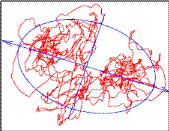
The test can be performed on the force platform alone, or with any specialized surface that will fit onto the force platform (wobble board, foam cushion, etc.).
The force platform is zeroed and the subject steps onto the force platform or other surface (perturbing foam may also be used) and assumes the position specified in the test settings.
Clinicians interested in the effect of a transient movement may give the subject the command to execute the movement in question (for example, to open or close his/her eyes) at the end of the pre‑test sequence.
If performing the test in static conditions, the subject maintains the specified position for the entire duration of the test. If performing the test in dynamic conditions, the subject does the desired movement in slow motion while the operator observes the real time screen, to identify the positions in which the sway significantly increases.
These are some of the numerical results available:
It is designed to quickly quantify the subject's usable area of support, i.e. his/her ability to sway in any direction.
Limit of Stability (LoS) test results are extremely important because a person's risk of falling depends not only on his/her ability to control sway (as tested using the BalanceTRAK® Static Module) but also on how large the usable area of support is.
This module allows you to perform a test that measures the actual maximum possible excursion of the subject's sway, not just the ability of the subject to sway a predetermined amount.
Muscular strength in the legs and feet, somatosensory feedback from the feet regarding the actual position of the center of pressure, as well as psychological aspects related to fear of falling, are all important factors affecting the ability of a person to sway in any direction.
With the Limit of Stability module you can:
BalanceTRAK® Limit of Stability Module makes it possible to identify deficits in a subject's ability to fully use his/her available area of support. This is important because such balance deficiencies can reduce their ability to withstand the perturbations to their balance that are an inherent part of their sport. Once eventual deficits are identified, the biofeedback functions of this module can be used in conjunction with a customized training or rehabilitation regimen to improve the subject's ability to fully use his/her area of support, which will result in better overall athletic performance.
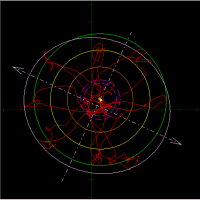
The subject is instructed to lean as far as he/she can in a specific direction (four orthogonal or eight 45° angle directions, with the eight directions providing the more complete and accurate results), without losing his/her balance. Visual feedback can be provided so the subject sees on the screen the direction in which to move, four limit of stability thresholds, a marker representing his/her current position and a trace following the movements already done.
It is designed to quantify the subject's ability to quickly and accurately shift his/her body weight to the desired position.
Unlike any other product on the market, the timing and geometry of the movement can be completely randomized to prevent the subject from using a preprogrammed movement strategy to reach the target, making it possible to evaluate not only the subject's weight‑shifting abilities, but also his/her reaction time.
This module is a great tool for those who work with athletes because an athlete's ability to shift his/her body quickly and on cue is essential in almost all sports.
This test can be used to identify the subject's ability to control his/her center of pressure while doing a weight shifting movement.
It can be used to aid in the detection and diagnosis of motor coordination as well as neuromuscular pathologies. The ability to present targets whose movements is constrained in specific directions also makes it possible to use this module for vestibular and neurological disorders that tend to manifest themselves as a reduced ability to control movements in specific directions.
Because of its interactive nature, this module is a great rehabilitation/exercise tool to improve the subject's ability to perform weight‑shifting movements, with an increased level of difficulty both in range of motion (larger movements) and in time (faster movements).
Progress during exercises is easily determined as the subject should be able to increase his/her speed, reaction time, accuracy of movement and range of sway in the desired directions if the exercises are done correctly and are actually effective for that subject.
Performance requiring fast and accurate movements is essential in many activities. The BalanceTRAK® Targeting module makes it possible to evaluate a subject's weight‑shifting abilities. Movement reaction time and accuracy are then used to score this ability.
The BalanceTRAK® Targeting module is very useful in identifying unilateral weaknesses or conditions that limit an athlete's performance in only certain directions or conditions.
And it can be successfully used as part of customized training or rehabilitation regimens to improve weight shifting and reaction time performance, as well as to monitor the subject's progress during treatment.
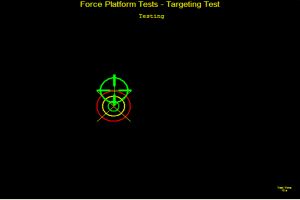
A series of targets are shown to the subject who has to shift his/her center of pressure to match the position of the target (the process is similar to the Saccade test that is done with the eyes, but because of the inertia involved, the timing and amplitude are much larger).
The position of the targets is defined with respect to the theoretical limit of stability of the subject, making the test more or less difficult depending on how far from the center of the limit of stability the targets appear.
Biofeedback is provided in real time by showing on the screen both the target and the instantaneous center of pressure of the subject (identified by a specific marker).
It is designed to provide a computerized, vastly improved version of the classic sit to stand maneuver.
The use of a force platform and specialized software allows clinicians to obtain not only an accurate and objective measurement of the time it takes a subject to perform the movement, but also provides a great deal of additional information that would otherwise be unavailable.
Biofeedback is provided in real time by showing on the screen the trace of the subject's center of pressure during the entire movement ‑ an invaluable tool for clinicians treating elderly patients or patients with a muscular pathology.
Because the sit to stand maneuver is recognized as a valid and useful measure of physical performance as it relates to daily living activities, this module can be invaluable in helping to objectively measure and document all the parameters of the standard sit to stand maneuver. It can also establish if the subject is at risk of losing his/her balance once he/she reaches a fully erect position after rising from a sitting position.
As a rehabilitation tool, it can be used to improve the subject's ability to perform a controlled sit to stand maneuver that is accompanied by a stable upright posture.
With this tool you can also teach different strategies to perform the sit to stand motion. Sit to stand is a common, very simple daily task, yet one that can often result in a fall, strained muscles, or increased pain from osteoarthritis or other muscular or joint pathologies.
As a biofeedback rehabilitation tool it can provide invaluable training in terms of optimizing the maximum load on the subject's lower extremities during this common daily activity.
Although not particularly geared for these kinds of applications, this module can be used to measure the subject's whole body reaction time, and as a low intensity physical performance test, measuring such quantities as the maximum force generated, maximum vertical acceleration, movement time and stabilization time.
These measures can be used to monitor the effects of training regimens and subject's progress because, in general, smaller values directly correlate with improved performance.
Where this module excels is in determining if the subject is suffering from conditions such as postural hypotension or other conditions whose onset is triggered by large postural changes that can cause temporarily reduced performance and poor balance.
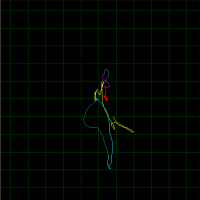
The test is performed by placing a chair as close as possible to the CAPS® Professional force platform without touching it. The subject then sits on the chair with his/her feet resting comfortably on the force platform. Then when instructed by the BalanceTRAK® software, the subject stands up, reaching the upright position and holding it until the end of the test. The subject should maintain the upright position without losing balance or needing to take a step to stabilize him/herself after the sit to stand maneuver. This allows BalanceTRAK® to calculate where the sit to stand maneuver ends and to accurately measure and quantify the subject's subsequent stability.
This module is an absolute necessity for anyone working with athletes.
This module is designed to quickly estimate force, power, and energy, as well as acceleration, velocity and displacement for any movement in the vertical direction that a subject positioned on the CAPS® Professional force platform is able to perform, from squatting to jumping (landing outside the force platform), and from push‑ups to weightlifting.
This module is uniquely suited for athletics/sports applications. The ability to measure force, power, and energy, as well as acceleration, velocity and displacement of various movements makes this a great training tool as well as an invaluable aid for monitoring and evaluating exercise and training regimens.
The ability to evaluate multiple repetitions of the same movement makes it possible to determine important aspects like fatigue thresholds that let you optimize the training regimen for the subject's condition, avoiding the risk of over‑training and its negative consequences.
The subject's progress during training can be easily quantified by repeating testing over time, allowing you to detect when the training is no longer improving performance, so you can make a decision regarding the usefulness of altering the training regimen.
The unique ability to show in real time not only the movement's variables, but also the center of pressure and the sway, are also very useful as a biofeedback training tool to improve the subject's technique in a variety of movements such as power squats, weightlifting and jumps (landing outside the force platform).
This module can be used to evaluate non‑isometric muscular activities of the lower limbs as well as of the torso or upper extremities. Limbs can be evaluated together or the movement and the set‑up can be altered so that each side of the body can be tested separately. The results may then be compared in order to uncover unilateral weaknesses.
It can also be used as a rehabilitation tool to monitor rehabilitation progress while restoring the subject's ability to perform specific movements in the vertical direction after injury, surgery or illness. This is done by checking to see if the subject is able to generate increasing power, energy or force, and can perform the movement faster or with an increased range of motion. As such, it can also be used to document functional progress and outcomes.
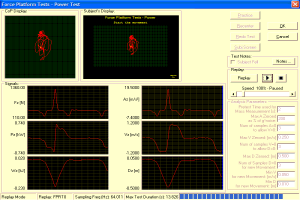
This module can be used to evaluate non‑isometric muscular activities of the lower limbs as well as of the torso or upper extremities. Limbs can be evaluated together or the movement and the set‑up can be altered so that each side of the body can be tested separately. The results may then be compared in order to uncover unilateral weaknesses.
It can also be used as a rehabilitation tool to monitor rehabilitation progress while restoring the subject's ability to perform specific movements in the vertical direction after injury, surgery or illness. This is done by checking to see if the subject is able to generate increasing power, energy or force, and can perform the movement faster or with an increased range of motion. As such, it can also be used to document functional progress and outcomes.

